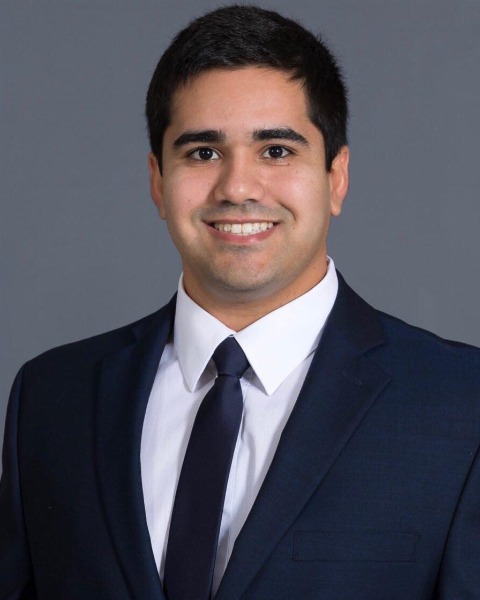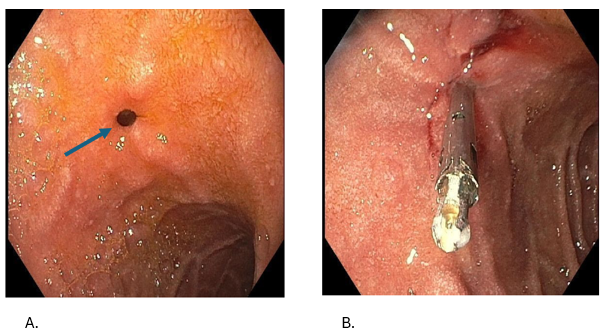Tuesday Poster Session
Category: Biliary/Pancreas
P4377 - Resolution of Recurrent Ascending Cholangitis After Endoscopic Closure of a Choledochoduodenostomy
Tuesday, October 28, 2025
10:30 AM - 4:00 PM PDT
Location: Exhibit Hall

Jose Nunez-Morales
VA Caribbean Healthcare System
Guaynabo, PR
Presenting Author(s)
Jose Nunez Morales, 1, Diego Roman-Colon, 2, Jose Martin-Ortiz, MD, FACG2
1VA Caribbean Healthcare System, Guaynabo, Puerto Rico; 2VA Caribbean Healthcare System, San Juan, Puerto Rico
Introduction: Choledocholithiasis occurs in 5-30% of patients with cholelithiasis. Standard of care is ERCP with endoscopic sphincterotomy and stone removal followed by cholecystectomy. Choledochoduodenostomy (CDD) is another option: a surgical biliary enteric anastomosis. Although effective for drainage, it can lead to long-term complications such as "Sump Syndrome". Enteric contents flow via the anastomosis into biliary tree, leading to recurrent ascending cholangitis. Managing strategies include medical therapy and ERCP with debris, sludge, and stone removal, providing temporary relief but not addressing the underlying etiology. Endoscopic closure using metallic clips offers a minimally invasive alternative and remains under-reported in the literature. Here we present a case of a patient with prior cholecystectomy and CDD with recurrent episodes of ascending cholangitis and multiple ERCP that resolved completely after endoscopic CDD closure with a metallic clip.
Case Description/
Methods: Case of a 75 y/o male with history of cholecystectomy and CDD 34 years ago due to recurrent episodes of jaundice and CBD stones. He underwent more than 4 ERCPs in another institution due to multiple episodes of CBD stones and ascending cholangitis. Due to chronic post-prandial abdominal pain, he underwent an MRCP before our evaluation that showed two filling defects in the distal CBD, consistent with choledocholithiasis. ERCP was done with prior CDD identified and two stones removed. Due to chronic abdominal pain and episodes of ascending cholangitis, a decision was made to perform EGD for closure of CDD. EGD was done, and CDD was successfully closed with hemoclip. At 1 and 2 months of follow-up, the patient exhibited marked improvement in symptoms. At 1 year of follow-up, he remained asymptomatic without any GI complaints and no new episodes of ascending cholangitis.
Discussion: This case underlines that enteric content reflux is a rare but important cause of recurrent cholangitis after CDD. Persistent symptoms despite normal imaging and diagnostic procedures, should raise suspicion of this etiology. This case highlights that endoscopic closure using clips can be safe and effective in selected patients. Although it is not routinely performed, this endoscopic approach should be considered in patients with persistent biliary infections and evidence of patent anastomosis without other clear etiology. Early recognition of this syndrome and targeted management can significantly improve patient outcomes and quality of life.

Figure: Figure 1. (A) Patent choledochoduodenostomy at EGD. (B) Successful closure of choledochoduodenostomy with hemoclip.
Disclosures:
Jose Nunez Morales indicated no relevant financial relationships.
Diego Roman-Colon indicated no relevant financial relationships.
Jose Martin-Ortiz indicated no relevant financial relationships.
Jose Nunez Morales, 1, Diego Roman-Colon, 2, Jose Martin-Ortiz, MD, FACG2. P4377 - Resolution of Recurrent Ascending Cholangitis After Endoscopic Closure of a Choledochoduodenostomy, ACG 2025 Annual Scientific Meeting Abstracts. Phoenix, AZ: American College of Gastroenterology.
1VA Caribbean Healthcare System, Guaynabo, Puerto Rico; 2VA Caribbean Healthcare System, San Juan, Puerto Rico
Introduction: Choledocholithiasis occurs in 5-30% of patients with cholelithiasis. Standard of care is ERCP with endoscopic sphincterotomy and stone removal followed by cholecystectomy. Choledochoduodenostomy (CDD) is another option: a surgical biliary enteric anastomosis. Although effective for drainage, it can lead to long-term complications such as "Sump Syndrome". Enteric contents flow via the anastomosis into biliary tree, leading to recurrent ascending cholangitis. Managing strategies include medical therapy and ERCP with debris, sludge, and stone removal, providing temporary relief but not addressing the underlying etiology. Endoscopic closure using metallic clips offers a minimally invasive alternative and remains under-reported in the literature. Here we present a case of a patient with prior cholecystectomy and CDD with recurrent episodes of ascending cholangitis and multiple ERCP that resolved completely after endoscopic CDD closure with a metallic clip.
Case Description/
Methods: Case of a 75 y/o male with history of cholecystectomy and CDD 34 years ago due to recurrent episodes of jaundice and CBD stones. He underwent more than 4 ERCPs in another institution due to multiple episodes of CBD stones and ascending cholangitis. Due to chronic post-prandial abdominal pain, he underwent an MRCP before our evaluation that showed two filling defects in the distal CBD, consistent with choledocholithiasis. ERCP was done with prior CDD identified and two stones removed. Due to chronic abdominal pain and episodes of ascending cholangitis, a decision was made to perform EGD for closure of CDD. EGD was done, and CDD was successfully closed with hemoclip. At 1 and 2 months of follow-up, the patient exhibited marked improvement in symptoms. At 1 year of follow-up, he remained asymptomatic without any GI complaints and no new episodes of ascending cholangitis.
Discussion: This case underlines that enteric content reflux is a rare but important cause of recurrent cholangitis after CDD. Persistent symptoms despite normal imaging and diagnostic procedures, should raise suspicion of this etiology. This case highlights that endoscopic closure using clips can be safe and effective in selected patients. Although it is not routinely performed, this endoscopic approach should be considered in patients with persistent biliary infections and evidence of patent anastomosis without other clear etiology. Early recognition of this syndrome and targeted management can significantly improve patient outcomes and quality of life.

Figure: Figure 1. (A) Patent choledochoduodenostomy at EGD. (B) Successful closure of choledochoduodenostomy with hemoclip.
Disclosures:
Jose Nunez Morales indicated no relevant financial relationships.
Diego Roman-Colon indicated no relevant financial relationships.
Jose Martin-Ortiz indicated no relevant financial relationships.
Jose Nunez Morales, 1, Diego Roman-Colon, 2, Jose Martin-Ortiz, MD, FACG2. P4377 - Resolution of Recurrent Ascending Cholangitis After Endoscopic Closure of a Choledochoduodenostomy, ACG 2025 Annual Scientific Meeting Abstracts. Phoenix, AZ: American College of Gastroenterology.
